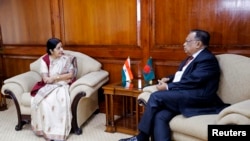India’s new government is moving ahead to deepen trade and investment ties with its neighbors, as South Asia remains one of the least economically integrated regions in the world.
Before wrapping up a visit to Bangladesh Friday, Indian foreign minister Sushma Swaraj announced several concessions: New Delhi will relax visa requirements, supply more power to its neighbor and increase investments to address a trade imbalance in its favor.
Swaraj pointed out that India would not be able to pursue its development agenda without bringing its smaller neighbors along with it.
This is the broader message from India’s month-old government as it promises to step up trade and investment with countries like Nepal, Bangladesh, Sri Lanka and Bhutan.
Indian foreign ministry spokesman Syed Akbaruddin said economic goals top the agenda.
“The overriding priority for India is to scale and speed our comprehensive national development and we will try to work out measures by which our diplomats in the region can assist in that national endeavor,” said Akbaruddin.
South Asia has been the flavor of the month in the Indian foreign ministry offices since Prime Minister Narendra Modi made the unprecedented gesture of inviting heads of neighboring countries to attend his inauguration. He followed that up with a visit to Bhutan in mid June.
Analysts say the stepped-up diplomacy is partly intended to limit China’s sphere of influence in South Asia. But equally important is a drive to give more primacy to trade in a region where political hostility and suspicion have impeded economic integration.
South Asia - a populous region of two billion people -- lags behind other parts of the world in regional trade. Economists compare the meager five percent of trade in this bloc to the more robust 25 percent in the Association of South East Asian Nations.
Cross border trade has been restricted between the region's two biggest countries, India and Pakistan, due to their hostile ties. A 2005 agreement to turn the region into a free trade zone has failed to yield substantive results. High tariffs remain an impediment.
Economist Rajiv Kumar at the Center for Policy Research in New Delhi says the key to better economic integration is to remove mistrust.
He is optimistic. Kumar said the new government has signaled that it will move to allow freer movement of goods, people and services.
“At the moment Bangladesh trucks are not allowed to come into India and go to wherever they want, or we do not allow access of Pakistani trucks to go across to Bangladesh, etc. All of that can change if India was to take a more magnanimous or more foresighted views, that this trade will only benefit us and open its borders and its markets to our neighbors. The most important part will be to India become more open, more liberal and permit our neighbors to benefit from our own growth and our own large market,” said Kumar.
India is promising to build new road and rail links in the region and boost infrastructure at border trading posts.
For example, Swaraj said India is willing to increase the frequency of a train service which links it to Bangladesh and will explore the possibility of starting a bus service between the two countries. A road connecting India to Myanmar, which is also known as Burma, is expected to open in October.
Analysts say revitalizing economic ties in South Asia could bring big benefits for a region that is battling high levels of poverty.






